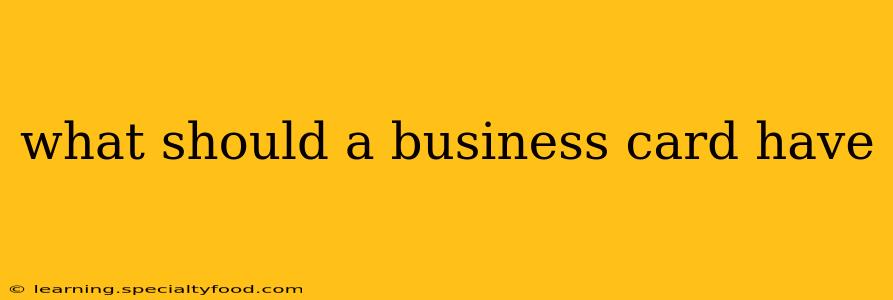What Should a Business Card Have? A Comprehensive Guide to Effective Business Card Design
In today's digital age, the humble business card might seem outdated. However, a well-designed card remains a powerful networking tool, offering a tangible connection in a virtual world. But what exactly should a business card have to make a lasting impression? This guide will cover the essential elements and some optional extras to consider.
What are the essential elements of a business card?
This is the core information your card needs to be effective:
- Your Name: This should be the most prominent element, easily readable and ideally in a slightly larger font size than the rest of the information. Consider using a professional font that's easy to read.
- Your Job Title: Clearly state your role within your company. This helps people understand your expertise and how they can benefit from connecting with you.
- Your Company Name: Make this clearly visible, ensuring it's consistent with your branding.
- Contact Information: This is crucial. Include:
- Phone Number: Use a professional number, ideally one directly connected to you or your business line.
- Email Address: A professional-sounding email address is key. Avoid using nicknames or unprofessional-looking addresses.
- Website Address (URL): If you have a professional website or online portfolio, include the URL.
What are some helpful additions to my business card?
While the above are essential, these additions can significantly enhance your card:
- Your Company Logo: A well-designed logo adds professionalism and brand recognition. Make sure it's clear and easily identifiable.
- Social Media Handles: Include relevant social media links (LinkedIn is almost always recommended for professional networking). Use shortened URLs for better readability.
- Address (Optional): Only include your business address if it's relevant to your business and clients need to visit your physical location. For most, a website or phone number is sufficient.
- QR Code (Optional): A QR code linking to your website or online portfolio can be a modern touch, allowing for easy access to more information. Ensure the code is clear and easily scannable.
- Tagline (Optional): A concise tagline that captures your company's mission or value proposition can add memorability. Choose a tagline that is both informative and memorable.
What should I avoid on my business card?
- Clichéd phrases: Avoid overused phrases or slogans that don't reflect your brand or personality.
- Too much information: Keep it concise and focused on the most important details. A cluttered card is hard to read and less effective.
- Poor-quality printing: Invest in professional printing to ensure your card looks crisp and professional. Cheap-looking cards reflect poorly on your business.
- Unprofessional images: Ensure any images used are professional and appropriate for your industry.
- Inconsistent branding: Ensure your business card aligns with your overall branding guidelines.
How do I choose the right materials for my business card?
The material you choose can greatly influence the overall impression. Standard options include:
- Standard paper stock: Affordable and widely available, but can feel less premium.
- Thick card stock: Offers a more substantial and luxurious feel.
- Recycled paper: A sustainable and eco-friendly option.
- Plastic or other specialty materials: These offer durability but might be less versatile.
What size should my business card be?
The standard business card size is 3.5 inches x 2 inches (89 mm x 55 mm). Sticking to this standard ensures your card fits easily in wallets and card holders.
By carefully considering these elements, you can create a business card that is both visually appealing and highly effective in promoting your brand and making a positive impression on potential clients and colleagues. Remember, your business card is often the first impression you make—make it count!
